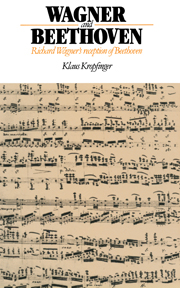Book contents
- Frontmatter
- Contents
- Preface
- Additional acknowledgements
- German and English abbreviations
- 1 Introduction
- 2 Wagner's experience of Beethoven
- 3 The Romantic background and Beethoven biography
- 4 Beethoven's role in Wagner's writings on art
- 5 Wagner's theory and construction of music drama
- 6 Wagner as Beethoven's heir
- Notes
- Bibliography
- Index of names
- Index of subjects
3 - The Romantic background and Beethoven biography
Published online by Cambridge University Press: 21 May 2010
- Frontmatter
- Contents
- Preface
- Additional acknowledgements
- German and English abbreviations
- 1 Introduction
- 2 Wagner's experience of Beethoven
- 3 The Romantic background and Beethoven biography
- 4 Beethoven's role in Wagner's writings on art
- 5 Wagner's theory and construction of music drama
- 6 Wagner as Beethoven's heir
- Notes
- Bibliography
- Index of names
- Index of subjects
Summary
The ‘Romantic image of Beethoven’
As Walter Wiora has shown, music as the ‘primal language of the soul’ and as the ‘geometrical meeting-point’ of various ‘trans-musical’ ideas was a basic fact of the Romantic universe. So was the experience of an intermingling of musical and extra-musical qualities; so too was the intention that the arts should complement one another.
It has been remarked by Wellek, Blume and others that Wagner was much indebted to the categories of Romantic thinking about music as developed in the critical and imaginative writings of E. T. A. Hoffmann, Novalis, Wackenroder, Tieck and Friedrich Schlegel, as well as in Schelling's philosophy. Knopf and Fries have particularly remarked on the links between the Romantic movement and Wagner's Gesamtkunstwerk, the ‘total work of art’.
In addition the Romantic interpretation of Beethoven's artistic personality and his works was a major stimulus for Wagner. Summing up these exegetical studies as the ‘Romantic image of Beethoven’, Arnold Schmitz has subjected them to critical analysis and has considered their transmission basically from the viewpoint of the history of ideas. In the process, the Romantic layers of the Beethoven image were stripped away to expose important sections of a portrait which is faithful to history. Beethoven no longer resembled a child of nature and a revolutionary, a magician and a priest – attributes created through an inspired act of forgery. A ‘Classical’ Beethoven took the place of the specifically Romantic composer.
- Type
- Chapter
- Information
- Wagner and BeethovenRichard Wagner's Reception of Beethoven, pp. 50 - 67Publisher: Cambridge University PressPrint publication year: 1991
- 1
- Cited by



